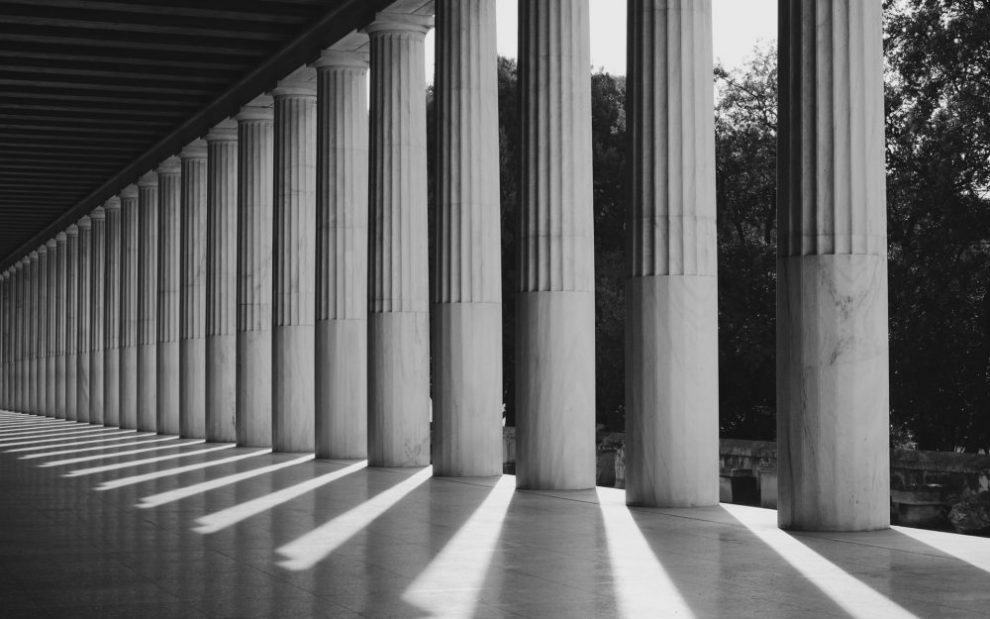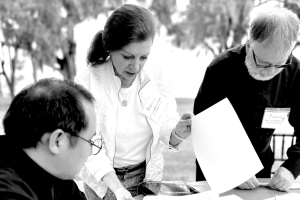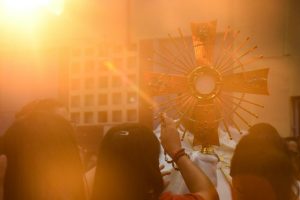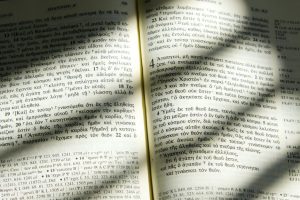For most of 2020 and the beginning of 2021, educators, students, and families alike were just hanging on to survive school in the midst of a pandemic. Some schools invested in new online software and hardware. Others implemented stringent sanitizing procedures and bought plexiglass shields to place between students and teachers. Nearly everyone was tired. It was not an ideal environment for innovation, new ideas, or new schools. But the Archdiocese of Boston decided to launch the planning of a brand-new school anyway, one that would marry classical education styles and content, dating back to the Greek and Roman Empires, with brand-new 21st-century technology. The archdiocese wanted to create a school designed to meet the needs of a new generation of Boston Catholic school students and families.
The school, now named Lumen Verum Academy, opened for classes in the fall of 2021 for grades six, seven, and eight. Lumen verum is Latin for “true light,” and Latin itself will be a cornerstone of a curriculum that borrows heavily from primary classical texts and languages while it minimizes the role of contemporary American and global scholarship.
Superintendent of Schools Thomas W. Carroll was an early and enthusiastic proponent of Lumen Verum, where students will work online from home on Mondays, Tuesdays, Thursdays, and Fridays and participate in on-site activities on Wednesdays and Saturdays. Carroll is a Catholic convert whose sons attended traditional same-sex Catholic schools in New York. His most recent experience before coming to Boston was running the Invest in Education Foundation, a school choice advocacy nonprofit in New York. He also worked in former New York governor George Pataki’s administration.
Carroll says he was an “atypical” candidate for the superintendent job in the Boston archdiocese because he had never attended Catholic schools and had never taught or worked in a diocese. However, with Catholic schools across the country facing budget crunches and declining enrollment, many archdioceses are beginning to look for candidates with experience in management and fundraising and often for those with political connections for lobbying and legislation favorable to private schools.
While classical schools are apolitical and nonpartisan, they receive support from conservative and Republican politicians and donors. With his experience in administration, policy, and donor relations, Carroll’s connections made starting a new classical school in Boston an apt fit.
Carroll says an early visit to St. Benedict Classical Academy, a school that wasn’t founded by the Boston archdiocese and that describes itself as “in the Catholic tradition,” convinced him that parents were “looking for something the archdiocese didn’t have.”
“My interest in doing Lumen Verum . . . has a lot of different angles to it. It’s not simply that it’s classical. . . . We were looking for a way to harness technology and deliver a higher-quality education, in contrast to a lot of substandard education,” Carroll says.
He says that, as a Catholic convert, he appreciates the beauty of the Catholic intellectual tradition and its role “as eternally standing for eternal truths.”
“Parents were looking for that and not always finding it in the Catholic schools in the country. I wanted children to be proud to be Catholic and unafraid of being a witness for their faith,” Carroll says. “We wanted a school that embraced the Catholic intellectual tradition . . . Western philosophical tradition . . . art, music, architecture, philosophy, science. . . . I wanted to make sure that children understood in a deep sense the moral teachings of the Catholic Church and had an ability to articulate and defend those truths.”
Carroll’s vision for Lumen Verum is a lofty one, but one that is echoed by much of the rhetoric around classical Catholic schools throughout the nation, which generally appeal most to relatively affluent and highly educated parents.
In the market-based view of education held by most school choice advocates, it makes sense to create schools based on the desires of parents, especially parents who can pay tuition. But that vision runs counter to a history of Catholic education in the United States that often involved recent immigrant families who paid very low tuition rates, due partially to the availability of religious sisters as teachers and educators, and homogeneous schools with uniforms and a typical structure.
“I know in a pretty dramatic way that in any system, whether it’s a district or religious system, there’s a temptation to have a lot of the schools look similar. That’s just not what we’re doing,” Carroll says about adding a nontraditional Catholic school to the Boston archdiocese.
One large group in the Boston archdiocese that Carroll hopes will be interested in Lumen Verum is Catholic homeschool parents who may struggle to serve as their children’s sole teacher after fifth grade, when the curriculum in math and science becomes more difficult.
“We want to create a market for homeschool families to pass the baton,” Carroll says.
Teaching with the grain
While Lumen Verum’s commitment to online, at-home education is unique among classical Catholic schools, its curriculum and student base are consistent with the increase in classical Catholic schools across the country. This appeals to Catholic families for whom traditional Catholic identity is very important and for whom public education or typical Catholic schools are thought to spend too much time on contemporary issues or ideas—such as race, gender, and sexuality—and not enough time on classical texts and Catholic traditions such as Latin Masses and eucharistic adoration.
The movement falls in line with a general movement in Catholicism toward traditionalism in worship styles and cultural identification, which aligns many Catholics with the Republican Party on social issues such as abortion or gay rights despite an American history of Catholics tending to register as Democrats.
The width and breadth of American Catholicism in the 21st century is evidenced by the fact that Speaker of the House Nancy Pelosi, President Joe Biden, Supreme Court Justice Amy Coney Barrett, and former Trump adviser Steve Bannon are all prominent Catholics.
Still, for most parents and students sorting through the morass of educational options in post-pandemic America, politics are not the primary concern. Instead, Catholic parents just want their children to get the best education possible and have it align with their Catholic faith.
Plus, as Catholic schools were quicker, in most cases, than public schools to return to in-person education during the pandemic, a whole set of new families entered into Catholic education for the first time in 2020 and 2021.
“On COVID-19 we get an A–,” says Kathy Mears, interim president of the National Catholic Educational Association (NCEA). “We really have done well. All year on any given day approximately 85 percent of our students were in-person learning from a teacher. . . . [We surveyed] 1,400 parents who tried Catholic schools for the first time, and more than 90 percent of them were very happy with the school.”
Clearly, not all—or even a majority—of the growth in students attending Catholic schools can be attributed to a growth in classical Catholic schools. Still, Catholics in leadership in dioceses all across the United States are noticing the success of prominent classical schools and working together to form new classical schools in their areas.
Mary Pat Donoghue, executive director of the secretariat of Catholic education for the United States Conference of Bishops (USCCB), drew the attention of the bishops for her work in implementing a classical Catholic curriculum at St. Jerome Academy, saving a struggling Catholic school in Hyattsville, Maryland.
Donoghue and her seven brothers and sisters attended St. Jerome’s as kids. Just before she helped turn it into a classical Catholic school, St. Jerome’s had experienced a 10-year reduction in enrollments. Donoghue describes the work of forming the new school as a “beautiful effort by many in the parish . . . to reimagine a Catholic school in light of the church’s long educational history.”
I wanted to make sure that children understood in a deep sense the moral teachings of the Catholic Church.Thomas W. Carroll
St. Joseph’s focuses its educational model around the classical liberal arts of Greek models of inquiry: the quadrivium of astronomy, mathematics, geometry, and music as well as the trivium of rhetoric, grammar, and dialectic or logic. These traditional liberal arts are taught through studying primary classical Greek and Latin texts, classical European art and music, and medieval Catholic theology. The new school started in 2010 and took between three and five years to fully implement, resulting in increased enrollment and a sustainable future at St. Jerome’s, where Donoghue says students are 30 to 40 percent Black and 12 to 15 percent Hispanic.
“You see an incredible joy [among students at classical Catholic schools],” Donoghue says. “Children get the opportunity to delve into the larger questions in the upper grades, and in the lower grades they get to observe and carefully render nature as they see it. It’s a stimulation of awe and wonder, and it’s all done very much in accordance with a child’s development.”
She describes classical educators as “teaching with the grain.”
The best way forward
Prior to her role at the USCCB, Donoghue worked at the Institute for Catholic Liberal Education (ICLE), which supports and organizes classical Catholic schools in the United States. One of her coworkers was Elisabeth Sullivan, an attorney and now the executive director for ICLE.
Sullivan says she’s convinced that a Catholic classical liberal arts education best serves the goals of teaching “love of God and love of neighbor.”
“This long, proven tradition of learning is based in the nature of reality and of the human person,” Sullivan says. “It feeds the mind, heart, and soul because it points to the divine reality beyond this temporal world. It lifts our sights higher. It inspires us. By contrast, the secular model of education has become mechanical and industrialized. It fosters apathetic learners and anxious students.”
Kimberly Martin Begg, an attorney and director of programs for the Ortner Family Foundation, which seeks to advance the Catholic Church and the classical and liberal arts education movement, is the editor of Catholic School Playbook and serves on staff at Young America’s Foundation, which “specializes in helping young people advance conservative ideas at their schools,” according to its website.
We gain absolutely nothing with gaining a Catholic school but losing our soul.Hosffman Ospino
Like Sullivan, Martin Begg believes in classical Catholic education as the best way forward for the church, families, and students. She took her children out of a Catholic school and moved them into a classical school “in the Catholic tradition” because she was unhappy with the teaching they received at their Catholic school.
“Parents were being asked to pay tuition to schools that weren’t all that different from what the public schools were offering,” she says. “[The schools] were using the curriculum and models of the secular world.”
Like many proponents of classical or liberal Catholic education, Martin Begg is critical of common core standards, which she calls “history without salvation history.”
While Sullivan and Martin Begg are both active in conservative causes, they both prefer the term liberal education to talk about classical schools, although Martin Begg notes that the term can be a misnomer or a turnoff to some families.
“I think that’s why a lot of the schools have embraced the word classical,” she says.
A fit for all
While a majority of Catholic school proponents and leaders tend to identify as conservative, the movement in general is not affiliated with the Republican Party. In addition, many more liberal areas of the country have seen a large rise in classical schools, officially Catholic or not.
Patrick Tomassi, dean of boys at Trinity Academy in Portland, Oregon, has previously written for America magazine about the “whitewashing” of the Catholic homeschool curriculum.
Tomassi, who has a degree in mechanical engineering, says he was initially impressed by the math and science content at Trinity, where his younger sister attended high school after leaving the diocesan Catholic school due to concerns about “drug use” and conflicting “culture issues.”
The biggest concern is that, because it’s the Roman tradition, it’s very European-centered.
Kathy Mears
While Tomassi is Catholic, Trinity is not an officially Catholic school; it recently saw its largest growth in enrollment with a large influx from a local Baptist megachurch. The school understands itself as “apolitical,” Tomassi says, and tries to model itself as a place where dialogue is preeminent. He mentions a series of dialogues begun by a student of color at Trinity to talk about race and racism, particularly after the 2020 police killing of George Floyd in Minneapolis and the requisite protests over racial injustice in Portland.
Tomassi says Trinity has “no official policy” about the teaching of sexuality, gender roles, and race. If a student were to come out as gay, “it would be a conversation between the head of school and me as dean of boys,” he says.
The challenges he notes of the inability of the Catholic homeschool curriculum to address issues of race were avoided by classical schools largely because classical schools are against textbooks.
“That ends up being our saving grace on a lot of this. . . . When you write a textbook, you can’t avoid having a bias,” he says.
Plus, Tomassi says he’s open to changes in the Western canon and notes Black classical scholars and educators like Cornel West and Anika Prather, who teaches in the classics department at Howard University in Washington, D.C. and founded the Living Water School, as nonwhite leaders who are “talking about what deserves to be in the canon.”
What’s the purpose?
Those efforts notwithstanding, classical Catholic schools, educators, and leaders tend to be affluent and white. Some are concerned that the curriculum is overwhelmingly dominated by European male thinkers.
“The biggest concern is that, because it’s the Roman tradition, it’s very European-centered,” says Mears. “There’s a concern that children whose ancestors don’t come from Europe, that their [ancestors’] stories aren’t being told or heard. . . . We don’t see many Latinos or people from the Caribbean enrolling in a [classical] Catholic school.”
Hosffman Ospino is chair of the department of religious education and pastoral ministry at Boston College and on the board of NCEA. He’s also a native of Colombia and an expert on Hispanic Catholic presence in American parishes and schools. Ospino says that about 45 percent of all Catholics self-identify as Hispanic, but likely less than 4 percent of Hispanic Catholic children are currently attending Catholic schools.
While Ospino says there are many factors in the low rate of Hispanic children attending Catholic schools in the United States, he notes that Catholic schools have not yet “shifted” to address the changing demographics of American Catholics. He does not necessarily see classical Catholic schools as meeting the needs of Hispanic Catholics either.
“Without a doubt there is value and potential. What I would ask is, what’s the purpose? Is it to serve primarily those Catholic families and other families that are willing to pay the big bucks? . . . If that’s the case, technically Catholic schools can end up being instruments of further exclusion of the largest Catholic school-aged population in the country,” Ospino says.
Ospino notes that many classical schools are being founded in mostly white European American upper-middle-class settings, while Catholic populations in the United States are growing fastest among Hispanic and Asian Americans in the South and Southwest.
“We need to figure out a way of making these resources available to the emergent populations of the South without turning [classical Catholic schools] into instruments of segregation or another private education option,” he says. “That’s always the dilemma. Everyone understands that Catholic education unfortunately is expensive. . . . [It is] vulnerable to donors that have a political agenda. We gain absolutely nothing with gaining a Catholic school but losing our soul.”
This article also appears in the September 2021 issue of U.S. Catholic (Vol. 86, No. 9, pages 26-30). Click here to subscribe to the magazine.
Image: Unsplash/Darryl Low













Add comment